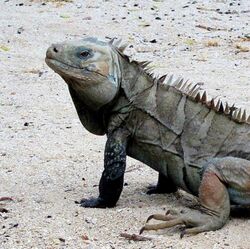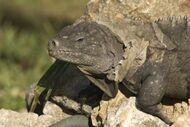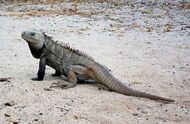Cyclura ricordi
Topic: Biology
 From HandWiki - Reading time: 8 min
From HandWiki - Reading time: 8 min
| Cyclura ricordi | |
|---|---|

| |
| Scientific classification | |
| Domain: | Eukaryota |
| Kingdom: | Animalia |
| Phylum: | Chordata |
| Class: | Reptilia |
| Order: | Squamata |
| Suborder: | Iguania |
| Family: | Iguanidae |
| Genus: | Cyclura |
| Species: | C. ricordi
|
| Binomial name | |
| Cyclura ricordi (A.M.C. Duméril & Bibron, 1837)
| |
Cyclura ricordi, commonly known as the Hispaniolan ground iguana, Ricord's ground iguana, Ricord's iguana, or Ricord's rock iguana, is an endangered species of rock iguana.[1] It is found on the island of Hispaniola (Haiti and the Dominican Republic), and is the only known species of rock iguana to coexist with the rhinoceros iguana (Cyclura cornuta).[2][3] Its natural habitat is dry savanna within three subpopulations in the southwestern Dominican Republic.[2][3] It is threatened by habitat loss due to agricultural encroachment.[2][3]
Etymology and taxonomy
The specific name, ricordi, is a Latinized form of the last name of French biologist Alexandre Ricord;[4] Ricord first wrote of the species in 1826.[5]
In 1837 Cyclura ricordi was described as a species new to science by André Marie Constant Duméril and Gabriel Bibron, who at that time named it Aloponotus ricordii. In 1843 the species was assigned to the genus Hypsilophus by Leopold Fitzinger. In 1885 the species was returned to the genus Aloponotus by Edward Drinker Cope. In 1924 the species was assigned to the genus Cyclura by Doris Mable Cochran.[6]
Morphological and genetic data indicate that the closest living relative of C. ricordi is C. carinata of the Turks and Caicos Islands.[7]
Anatomy and morphology
Ricord's iguana is a large species of rock iguana with a head and body length in males of 49–51 cm (19–20 in), and in females of 40–43 cm (16–17 in), with an equally long tail.[8] The toes of Ricord's iguana are articulated to be efficient in digging and climbing trees.[8]
Their body color is a grayish green flat color marked by five to six bold pale gray chevrons alternating with dark gray to black chevrons.[8] In adults, the dark chevrons are less contrasting than in juveniles.[8] Ricord's iguana's eyes have a dark almost black iris and red sclera.
This species, like other species of Cyclura, is sexually dimorphic; males are larger than females, and have more prominent dorsal crests as well as larger femoral pores on their thighs, which are used to release pheromones.[9][10]
Ricord's iguanas have excellent vision, which allows them to detect shapes and motions at long distances.[11] As Ricord's iguanas have only a few Rod cells they have poor vision in low-light conditions. At the same time they have cells called “double cones” which give them sharp color vision and enable them to see ultraviolet wavelengths.[11] This ability is highly useful when basking so the animal can ensure that it absorbs enough sunlight in the forms of UVA and UVB to produce Vitamin D.[9]
Like other Cyclura iguanas, Ricord's iguanas have evolved a white photosensory organ on the top of their heads called the parietal eye, which are also called third eye, pineal eye or pineal gland.[11] This “eye” does not work the same way as a normal eye does as it has only a rudimentary retina and lens and thus, cannot form images.[11] It is however sensitive to changes in light and dark and can detect movement.[11]
Primarily herbivorous, Ricord's iguanas are presented with a special problem for osmoregulation: plant matter contains more potassium and as it has less nutritional content per gram, more must be eaten to meet the lizard's metabolic needs.[12] As Ricord's iguanas are not capable of creating liquid urine more concentrated than their bodily fluids, like birds they excrete nitrogenous wastes as urate salts through a salt gland.[12] As a result, Ricord's iguanas have developed this lateral nasal gland to supplement renal salt secretion by expelling excess potassium and sodium chloride.[12]
Diet
Ricord's iguana, like most Cyclura ssp is primarily herbivorous, consuming leaves, flowers, berries, and fruits from different plant species. A study in 2000 by Dr Allison Alberts of the San Diego Zoo revealed that seeds passing through the digestive tracts of Cycluras germinate more rapidly than those that do not.[13][14] The seeds in the fruits consumed by Cyclura iguanas have an adaptive advantage by sprouting before the end of very short rainy seasons.[14] Ricord's iguana is an important means of distributing these seeds to new areas (particularly when females migrate to their nesting areas) and, as one of the largest native herbivores of their Hispaniola's ecosystem, they are essential for maintaining the balance between climate and vegetation.[14]
Distribution and habitat
Ricord's iguana inhabits dry xeric scrubland with sandy and earthen soils in which they excavate burrows for retreats and nest sites that they expand over time.[2] Entrances to these burrows are generally dug under dense thorny vegetation, shrubs, stumps, or exposed rocks.[2] The adults of the species are primarily terrestrial whereas juveniles tend to occupy arboreal retreats.[15][16]
Ricord's iguana was thought until 2008 to be found only in the southwestern Dominican Republic, where it is restricted to the arid Valle de Neiba and the most xeric portion of the Peninsula de Barahona coastal lowlands.[8] These two populations are separated by the Sierra de Bahoruco (Massif de la Selle in Haiti), with three peaks exceeding 2,000 metres (6,600 ft) that form an extensive ecological barrier.[8][17] Past drier Pleistocene climates may have allowed genetic exchange between the two subpopulations.[8] Throughout their range, Ricord's iguanas coexist with rhinoceros iguanas and both species have been observed swimming and floating in freshwater by herpetologist Jose Ottenwalder.[8] In 2008 it was found to exist in Anse-a-Pitres, Haiti.[18] All other Caribbean islands, if they do have a rock iguana species, are home to a single species.[16]
Mating
Mating occurs from May through June.[2][17] Copulation is preceded by numerous head-bobs on the part of the male, who then circles around behind the female and grasps the nape of her neck.[17] He then attempts to restrain the female in order to maneuver his tail under hers to position himself for intromission.[17] Copulation generally lasts from 30 to 90 seconds, and a pair is rarely observed mating more than once or twice a day.[17] Anywhere from two to eighteen eggs are usually laid in June or July depending on the size and age of the female, in nests excavated in pockets of earth exposed to the sun.[2] The eggs go through a 90- to 100-day incubation period hatching in September and October.[2] It has been noted that Cyclura eggs are some of the largest eggs laid by any lizard.[17]
Threats
On the Barahona Peninsula, the population of Ricord's iguanas has been threatened by agricultural displacement through increased farming and cattle grazing as well as charcoal mining.[19] The iguanas are hunted and trapped as a food source by humans and killed by goatherders under the false superstition that iguanas rip open the bellies of livestock with their pointed crests.[19][20] Competition from domestic and feral livestock is also a concern as is predation of juveniles by cats and dogs.[19] They are also poached for the illegal exotic animal trade, commanding a high price with collectors.
Conservation
The estimated wild population is only 3,000-4,000 animals making this species endangered.[1][21] The Indianapolis Zoo has been involved in the Dominican Republic for almost ten years and will continue its research and conservation efforts with the Ricord's iguana.[22] The zoo's Project Iguana aids the survival of West Indian iguanas and their habitats through in-site conservation, captive breeding, public education, and scientific research.[16]
The project's goals are:
- to work with the Ricord's Iguana Recovery Group to implement the ISG's Species Recovery Plan
- to conduct a census of iguanas on Isla Cabritos, Dominican Republic.[22]
- to determine vitamin D status of captive West Indian iguanas at the Zoo before and after exposure to sunlight
- to work in partnership with ZOODOM (the national zoo of the Dominican Republic) to develop a long-term captive breeding and husbandry program for Ricord's iguanas.[22]
- to develop an education program for West Indian iguanas and their habitats.[19]
References
- ↑ 1.0 1.1 1.2 Pasachnik, S.A.; Carreras de León, R. (2019). "Cyclura ricordii" (in en). IUCN Red List of Threatened Species 2019. https://www.iucnredlist.org/species/6032/3098833. Retrieved 18 July 2019.
- ↑ 2.0 2.1 2.2 2.3 2.4 2.5 2.6 2.7 Ottenwalder, J. (1996). "Cyclura ricordii". IUCN Red List of Threatened Species 1996: e.T6032A12348520. doi:10.2305/IUCN.UK.1996.RLTS.T6032A12348520.en. https://www.iucnredlist.org/species/6032/12348520.
- ↑ 3.0 3.1 3.2 Hudson, Rick (2007-04-01). "Big Lizards, Big Problems". Reptiles Magazine 15 (4): 58.
- ↑ Beolens, Bo; Watkins, Michael; Grayson, Michael (2011). The Eponym Dictionary of Reptiles. Baltimore: Johns Hopkins University Press. xiii + 296 pp. ISBN:978-1-4214-0135-5. (Anolis ricordi, p. 221).
- ↑ Hollingsworth, Bradford D. (2004), "The Evolution of Iguanas: An Overview of Relationships and a Checklist of Species", Iguanas: Biology and Conservation (University of California Press): pp. 43, ISBN 978-0-520-23854-1
- ↑ "Cyclura ricordi ". The Reptile Database. www.reptile-database.org.
- ↑ Alberts, Allison (2007). "Turks & Caicos Iguana, Cyclura carinata carinata Conservation & Mgmt. Plan 2005 - 2009" (PDF). Iguana Specialist Group. http://www.iucn-isg.org/recoveryplan/dnld1.php?application=application/octet-stream&fileName=TCI-CAMP-4July2007_Sml.pdf. Retrieved November 26, 2007. [|permanent dead link|dead link}}]
- ↑ 8.0 8.1 8.2 8.3 8.4 8.5 8.6 8.7 Ottenwalder, Jose (2007), "Ricord's Iguana Cyclura ricordi", Iguana Specialist Group, archived from the original on October 28, 2007, https://web.archive.org/web/20071028100324/http://www.iucn-isg.org/actionplan/ch2/ricords.php, retrieved November 26, 2007
- ↑ 9.0 9.1 De Vosjoli, Phillipe; Blair, David (1992), The Green Iguana Manual, Escondido, California: Advanced Vivarium Systems, ISBN 1-882770-18-8, https://archive.org/details/greeniguanamanua00phil
- ↑ Martins, Emilia P.; Lacy, Kathryn (2004), "Behavior and Ecology of Rock Iguanas, I: Evidence for an Appeasement Display", Iguanas: Biology and Conservation (University of California Press): pp. 98–108, ISBN 978-0-520-23854-1
- ↑ 11.0 11.1 11.2 11.3 11.4 Brames, Henry (2007). "Aspects of Light and Reptile Immunity". Iguana: Conservation, Natural History, and Husbandry of Reptiles (International Reptile Conservation Foundation) 14 (1): 19–23.
- ↑ 12.0 12.1 12.2 Hazard, Lisa C. (2004), "Sodium and Potassium Secretion by Iguana Salt Glands", Iguanas: Biology and Conservation (University of California Press): pp. 84–85, ISBN 978-0-520-23854-1
- ↑ Derr, Mark (October 10, 2000), "In Caribbean, Endangered Iguanas Get Their Day", New York Times Science Section
- ↑ 14.0 14.1 14.2 Alberts, Allison; Lemm, Jeffrey; Grant, Tandora; Jackintell, Lori (2004), "Testing the Utility of Headstarting as a Conservation Strategy for West Indian Iguanas", Iguanas: Biology and Conservation (University of California Press): pp. 210, ISBN 978-0-520-23854-1
- ↑ Sanchez, Alejandro. "Family Iguanidae: Iguanas and Their Kin". Father Sanchez's Web Site of West Indian Natural History Diapsids I: Introduction; Lizards. Kingsnake.com. http://www.kingsnake.com/westindian/metazoa10.html. Retrieved November 26, 2007.
- ↑ 16.0 16.1 16.2 Foster PhD, John Scott (August 2005) (PDF), Saving Ricord's Iguana: Conservation and Education in the Dominican Republic, Association of Zoos and Aquariums Communique, pp. 19–20, archived from the original on 2007-02-21, https://web.archive.org/web/20070221130952/http://www.aza.org/Publications/2005/08/Iguanas.pdf
- ↑ 17.0 17.1 17.2 17.3 17.4 17.5 Blair, David (1991), "West Indian Iguanas of the Genus Cyclura: Their Current Status in the Wild, Conservation Priorities and Efforts to Breed Them in Captivity" (PDF), Northern California Herpetological Society Special Publication SE (6): pp. 55–56, archived from the original on 2008-04-11, https://web.archive.org/web/20080411062032/http://images.cyclura.com/download/pdf/WestIndianRockIguanas.PDF
- ↑ Accime, Masani, Ricord's Iguana Project: Message from our research team, archived from the original on 2012-11-01, https://web.archive.org/web/20121101023412/http://www.iguanafoundation.org/s18-105-Ricords-Iguana-Project.aspx, retrieved 2012-02-12
- ↑ 19.0 19.1 19.2 19.3 Rupp, Ernst; Inchaustegui, Sixto; Arias, Yvonne (December 1, 2005). "Conservation of Cyclura ricordii in the Southwestern Dominican Republic and a Brief History of the Grupo Jaragua". Iguana: Journal of the International Iguana Society 12 (4): 222–234.
- ↑ Rupp, Ernst; Inchaustegui, Sixto; Arias, Yvonne (2005). "Preliminary Report on the Distribution and Situation of Cyclura ricordi on the Southern Shore of Enriquillo Lake". El Vergel (Santo Domingo, Dominican Republic) (33): 1–12.
- ↑ Alberts, Allison; Hudson, Richard D (2004), "The Role of Zoos in the Conservation of West Indian Iguanas", Iguanas: Biology and Conservation (University of California Press): pp. 275, ISBN 978-0-520-23854-1
- ↑ 22.0 22.1 22.2 Wyatt III, John E. (2003). "Indianapolis Zoo Conducts Ricord’s Iguana Field Research". Project Iguana. Indianapolis Zoo. Archived from the original on 2008-02-06. https://web.archive.org/web/20080206075102/http://www.indyzoo.com/content.aspx?cid=351. Retrieved 2007-10-04.
Further reading
- Duméril, A.M.C.; Bibron, G. (1837). Erpétologie générale ou Histoire naturelle complète des Reptiles. Tome quatrième [Volume 4]. Paris: Librairie Encyclopédique de Roret. 571 pp. + errata et emendanda. (Aloponotus ricordii, new species, pp. 190–192). (in French).
External links
- International Iguana Foundation
- Images of Cyclura ricordi
- Other images of Cyclura ricordi
- Cyclura ricordi on Biolib.cz
- Video of Cyclura ricordi on YouTube
Wikidata ☰ Q1586682 entry
 KSF
KSF


